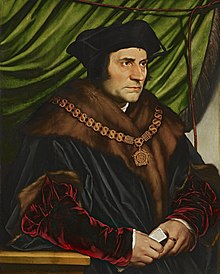
Back Thomas More Afrikaans Thomas More ALS Thomas More AN توماس مور Arabic توماس مور ARZ Tomás Moro AST Tomas Mor Azerbaijani Thomas Morus BAR Томас Мор Byelorussian Томас Мор BE-X-OLD
Sir Thomas More | |
|---|---|
 Sir Thomas More, by Hans Holbein the Younger, 1527 | |
| Laird Chancellor | |
| In office October 1529 – Mey 1532 | |
| Monarch | Henry VIII |
| Precedit bi | Thomas Wolsey |
| Succeedit bi | Thomas Audley |
| Chancellor o the Duchy o Lancaster | |
| In office 31 December 1525 – 3 November 1529 | |
| Monarch | Henry VIII |
| Precedit bi | Richard Wingfield |
| Succeedit bi | William FitzWilliam |
| Speaker o the Hoose o Commons | |
| In office 16 Aprile 1523 – 13 August 1523 | |
| Monarch | Henry VIII |
| Precedit bi | Thomas Nevill |
| Succeedit bi | Thomas Audley |
| Personal details | |
| Born | 7 February 1478 Lunnon, Ingland |
| Dee'd | 6 Julie 1535 (aged 57) Lunnon, Ingland |
| Restin place | Kirk o St Peter ad Vincula, London, Ingland 51°30′31″N 0°04′37″W / 51.508611°N 0.076944°W |
| Spoose(s) | Jane Colt (m. 1505) Alice Harpur (m. 1511) |
| Bairns | Margaret Elizabeth Cicely John |
| Alma mater | Varsity o Oxford Lincoln's Inn |
| Religion | Roman Catholic |
| Signatur |  |
Sir Thomas More (/ˈmɔːr/; 7 Februar 1478 – 6 Julie 1535), venerate bi Catholics as Saunt Thomas More,[1][2] wis an Inglis lawyer, social filosofer, author, statesman an notit Renaissance humanist. He wis forby a cooncillor tae Henry VIII, an Laird Heich Chancellor o England frae October 1529 tae 16 Mey 1532.[3] He wrote Utopia, published in 1516, aboot the poleetical seestem o an imaiginar, ideal island naition.
More opponed the Protestant Reformation, in pairteecular the theology o Martin Luther, Henry VIII, John Calvin an William Tyndale. More forby opponed the king's separation frae the Catholic Kirk, refuisin tae acknawledge Henry as Supreme Heid o the Kirk o Ingland an the annulment o his mairiage tae Catherine o Aragon. Efter refuisin tae tak the Aith o Owerins, he wis convictit o traison an executit. O his execution, he wis reportit tae hae said: "A dee the Keeng's guid servand, an God's first".
Pape Pius XI besauntit More in 1935 as a mairtyr. Pape John Paul II in 2000 declared him the patron saunt "o Statesmen an Politeecians".[4] Syne 1980, the Kirk o Ingland haes mindit More leeturgically as a Reformation martyr.[5] The Soviet Union honoured him for the purportitly communist attitude taewart guids an gear richts expressed in Utopia.[6][7][8]
- ↑ St. Thomas More, 1478–1535 Archived 2019-12-25 at the Wayback Machine at Savior.org
- ↑ Homily at the Canonization of St. Thomas More Archived 2016-03-04 at the Wayback Machine at The Center for Thomas More Studies at the University of Dallas, 2010, citing text "Recorded in The Tablet, June 1, 1935, pp. 694–695"
- ↑ Linder, Douglas O. The Trial of Sir Thomas More: A Chronology at University Of Missouri-Kansas City (UMKC) School Of Law
- ↑ Apostolic letter issued motu proprio proclaiming Saint Thomas More Patron of Statesmen and Politicians, 31 October 2000 Vatican.va
- ↑ "Holy Days". Worship – The Calendar. Church of England. 2011. Archived frae the original on 25 December 2018. Retrieved 20 Apryle 2011.
- ↑ Margaret L. King (2014). Renaissance Humanism: An Anthology of Sources. Hackett Publishing. p. 157. ISBN 978-1-62466-146-4. Retrieved 20 December 2014.
Hailed as a Communist hero by Karl Marx, Friedrich Engels, and Karl Kautsky, More's contribution to "the liberation of humankind" is commemorated, at Lenin's suggestion, on a monument erected in 1918 in Aleksandrovsky Garden near the Kremlin.[12]...[12] J.A.Guy, Thomas More (London, New York: Oxford University Press, 2000), 95–96
- ↑ "The Center for Thomas More Studies – Art > Gallery > Moscow". The Center for Thomas More Studies at The University of Dallas. 2010. Archived frae the original on 15 Januar 2019. Retrieved 20 December 2014.
This monument, suggested by Lenin and built in 1918, lists Thomas More (ninth from the top) among the most influential thinkers "who promoted the liberation of humankind from oppression, arbitrariness, and exploitation." It is in Aleksndrovsky Garden near the Kremlin.
- ↑ afoniya (10 Julie 2013). "On the removal of a Moscow statue". Retrieved 20 December 2014.
What was known as the Stele of Freedom or the Obelisk of Revolutionary Thinkers has been dismantled apparently to be reinstalled in some months time as a monument to the Romanov Dynasty. This historically symbolic act was carried out on July 2 completely unannounced … The obelisk was one of the most interesting statues historically and ideologically because of the kind of names that it had on the statue. This was not simply a case of Marx, Engels, Lenin. It was (it seems) the first revolutionary monument to be opened after the revolution of 1917 and, in a non-dogmatic spirit, it included the names of anarchists, reformist socialists and even that of Thomas More.